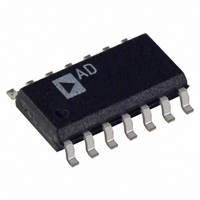OP462GSZ Analog Devices Inc, OP462GSZ Datasheet - Page 16

OP462GSZ
Manufacturer Part Number
OP462GSZ
Description
IC OPAMP GP R-R 15MHZ LN 14SOIC
Manufacturer
Analog Devices Inc
Type
General Purpose Amplifierr
Datasheet
1.OP162GSZ.pdf
(20 pages)
Specifications of OP462GSZ
Slew Rate
13 V/µs
Amplifier Type
General Purpose
Number Of Circuits
4
Output Type
Rail-to-Rail
Gain Bandwidth Product
15MHz
Current - Input Bias
260nA
Voltage - Input Offset
25µV
Current - Supply
550µA
Current - Output / Channel
30mA
Voltage - Supply, Single/dual (±)
2.7 V ~ 12 V, ±1.35 V ~ 6 V
Operating Temperature
-40°C ~ 125°C
Mounting Type
Surface Mount
Package / Case
14-SOIC (3.9mm Width), 14-SOL
Op Amp Type
Low Power
No. Of Amplifiers
4
Bandwidth
15MHz
Supply Voltage Range
2.7V To 12V
Amplifier Case Style
SOIC
No. Of Pins
14
Rail/rail I/o Type
Rail to Rail Output
Number Of Elements
4
Unity Gain Bandwidth Product
15MHz
Common Mode Rejection Ratio
70dB
Input Offset Voltage
325uV
Input Bias Current
600nA
Single Supply Voltage (typ)
3/5/9V
Dual Supply Voltage (typ)
±3/±5V
Voltage Gain In Db
98.89dB
Power Supply Rejection Ratio
120dB
Power Supply Requirement
Single/Dual
Shut Down Feature
No
Single Supply Voltage (min)
2.7V
Single Supply Voltage (max)
12V
Dual Supply Voltage (min)
±1.35V
Dual Supply Voltage (max)
±6V
Technology
BiCOM
Operating Temp Range
-40C to 125C
Operating Temperature Classification
Automotive
Mounting
Surface Mount
Pin Count
14
Package Type
SOIC N
Lead Free Status / RoHS Status
Lead free / RoHS Compliant
-3db Bandwidth
-
Lead Free Status / Rohs Status
Compliant
Available stocks
Company
Part Number
Manufacturer
Quantity
Price
Part Number:
OP462GSZ
Manufacturer:
ADI/亚德诺
Quantity:
20 000
Part Number:
OP462GSZ-REEL
Manufacturer:
ADI/亚德诺
Quantity:
20 000
Part Number:
OP462GSZ-REEL7
Manufacturer:
ADI/亚德诺
Quantity:
20 000
OP162/OP262/OP462
APPLICATION CIRCUITS
SINGLE-SUPPLY STEREO HEADPHONE DRIVER
Figure 46 shows a stereo headphone output amplifier that can
operate from a single 5 V supply. The reference voltage is
derived by dividing the supply voltage down with two 100 kΩ
resistors. A 10 µF capacitor prevents power supply noise from
contaminating the audio signal and establishes an ac ground for
the volume control potentiometers.
The audio signal is ac-coupled to each noninverting input
through a 10 µF capacitor. The gain of the amplifier is con-
trolled by the feedback resistors and is (R2/R1) + 1. For this
example, the gain is 6. By removing R1, the amplifier would
have unity gain. To short-circuit protect the output of the
device, a 169 Ω resistor is placed at the output in the feedback
network. This prevents any damage to the device if the head-
phone output becomes shorted. A 270 µF capacitor is used at
the output to couple the amplifier to the headphone. This value
is much larger than that used for the input because of the low
impedance of headphones, which can range from 32 Ω to 600 Ω
or more.
RIGHT IN
LEFT IN
5V
10µF
10µF
100kΩ
10kΩ
10kΩ
10µF
Figure 46. Headphone Output Amplifier
L VOLUME
CONTROL
R VOLUME
CONTROL
R1 = 10kΩ
R1 = 10kΩ
100kΩ
10µF
10µF
OP262-A
OP262-B
R2 = 50kΩ
5V
5V
R2 = 50kΩ
169Ω
169Ω
270µF
47kΩ
47kΩ
270µF
HEADPHONE
LEFT
HEADPHONE
RIGHT
Rev. F | Page 16 of 20
INSTRUMENTATION AMPLIFIER
Because of their high speed, low offset voltages, and low noise
characteristics, the OP162/OP262/OP462 can be used in a wide
variety of high speed applications, including precision instru-
mentation amplifiers. Figure 47 shows an example of such an
application.
The differential gain of the circuit is determined by R
with the R
gain to unity.
The fourth op amp, OP462-D, is optional and is used to
improve CMRR by reducing any input capacitance to the
amplifier. By shielding the input signal leads and driving the
shield with the common-mode voltage, input capacitance is
eliminated at common-mode voltages. This voltage is derived
from the midpoint of the outputs of OP462-A and OP462-B by
using two 10 kΩ resistors followed by OP462-D as a unity-gain
buffer.
It is important to use 1% or better tolerance components for the
2 kΩ resistors, as the common-mode rejection is dependent on
their ratios being exact. A potentiometer should also be connected
in series with the OP462-C noninverting input resistor to ground
to optimize common-mode rejection.
The circuit in Figure 47 was implemented to test its settling
time. The instrumentation amp was powered with −5 V, so the
input step voltage went from −5 V to +4 V to keep the OP462
within its input range. Therefore, the 0.05% settling range is
when the output is within 4.5 mV. Figure 48 shows the positive
slope settling time to be 1.8 µs, and Figure 49 shows a settling
time of 3.9 µs for the negative slope.
–V
+V
IN
IN
A
OP462-D
DIFF
G
=
Figure 47. High Speed Instrumentation Amplifier
resistor value in kΩ. Removing R
1 +
R
2
G
R
G
OP462-A
OP462-B
1kΩ
1kΩ
10kΩ
10kΩ
2kΩ
2kΩ
1.9kΩ
200Ω
10 TURN
(OPTIONAL)
OP462-C
G
2kΩ
sets the circuit
G
, where
OUTPUT













